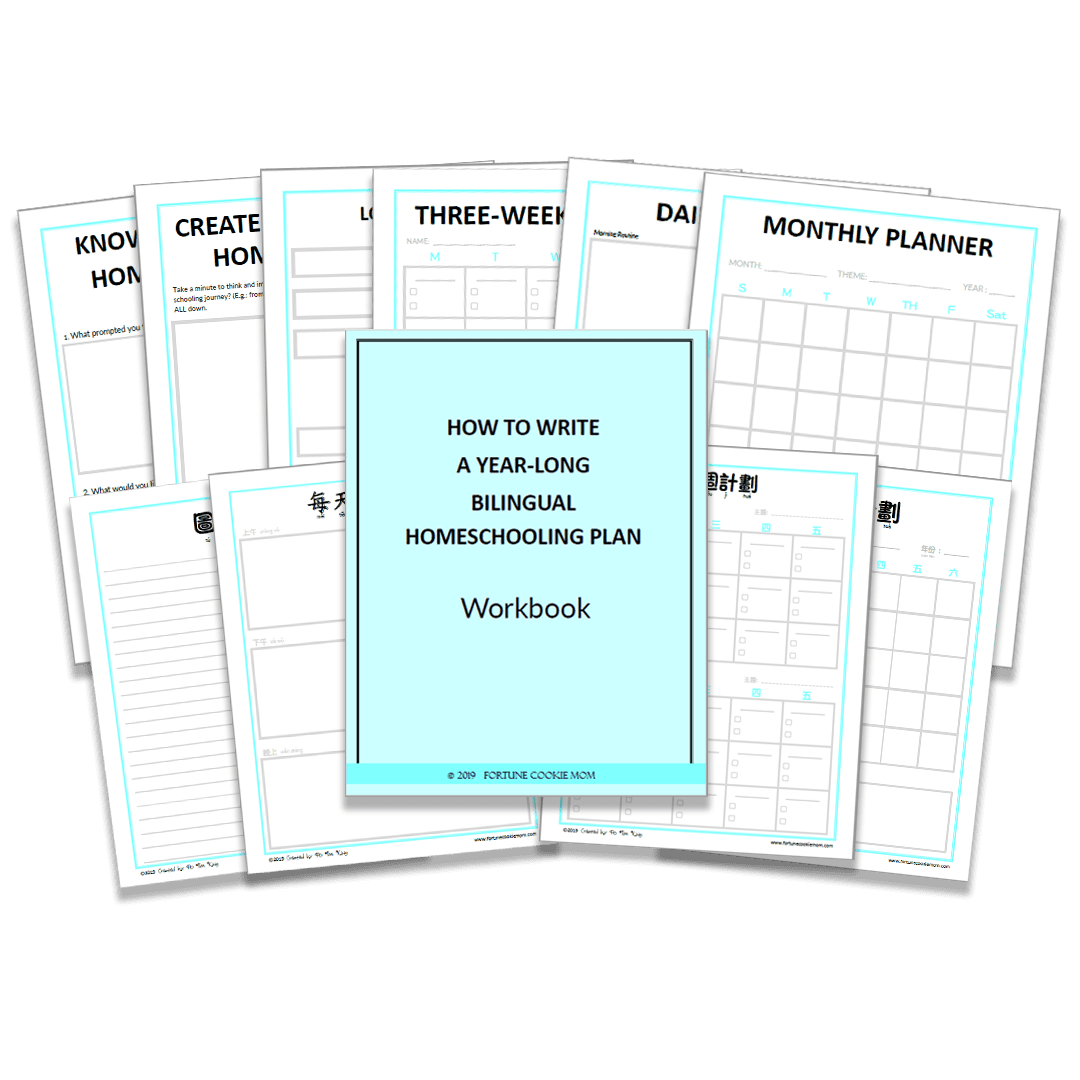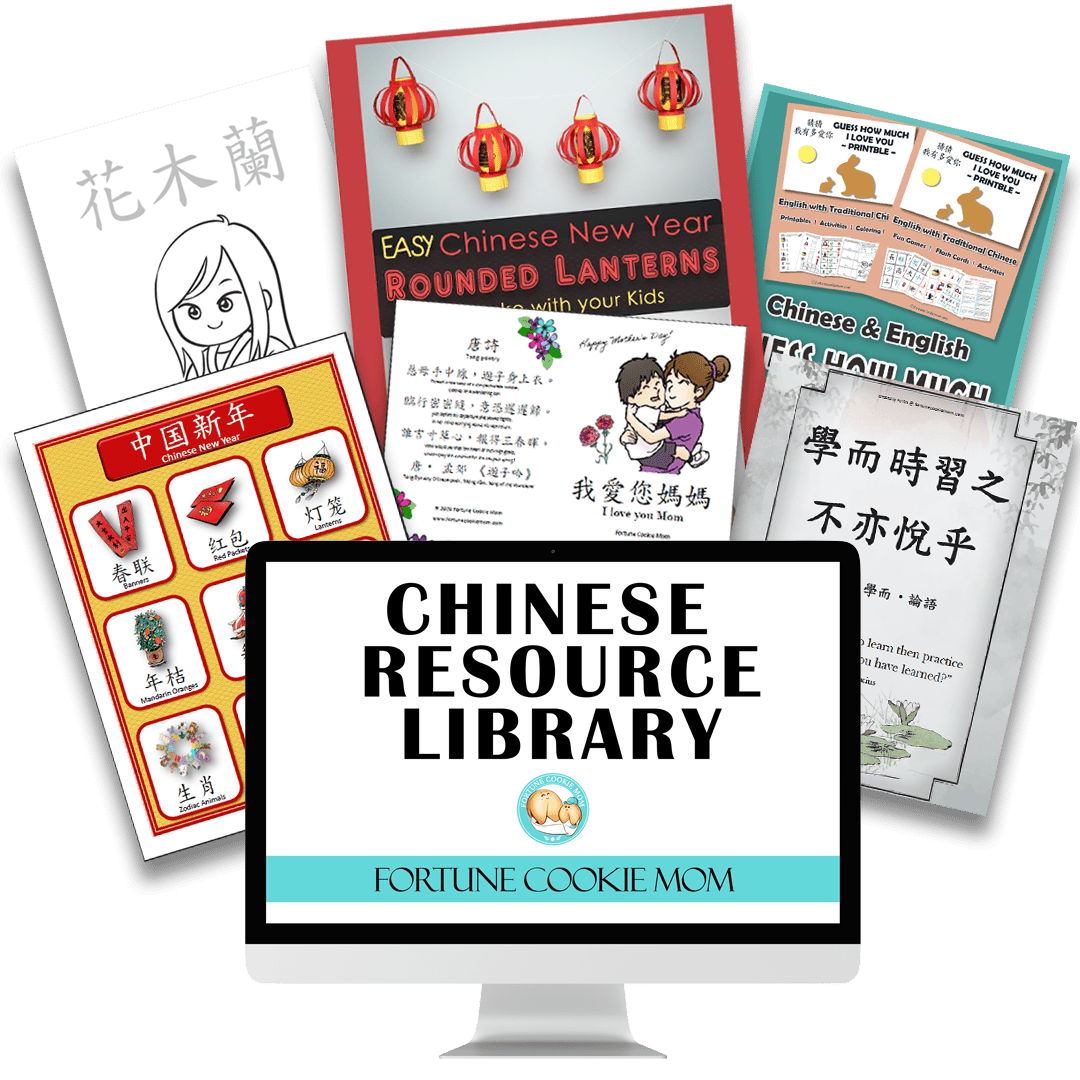One of the most frequent questions that I receive is:
- How do you write a year-long bilingual homeschooling plan? For both English and Chinese?
- Do you plan for all 4 kids? How?
- Where do I start?
It’s not an easy topic to write about because there is a lot of variation and different circumstances for the individual family regarding planning bilingual homeschooling. So, I would like to show you how I write my bilingual homeschooling plan for four kids in advance. With some simple steps as a reference and inspiration to help you get started.
I’m also going to turn it into a series of four blog posts with more in-depth details and information.
And a bonus post that you don’t want to miss at the end!
Let me know in the comments if this series is helpful or not. And if you have any suggestions or questions for me, feel free to leave your comments below as well.
Are you ready? Let’s get started!
The post contains affiliate links, which means I may receive a small commission, at no cost to you. If you make a purchase through a link. See the Disclosure for more details.
Table of Contents
* Please scroll down to download a Freebie.
Trust me, it is not easy to come up with bilingual homeschooling plans that include different subjects and activities for all four kids. I have done a lot of research, thinking, and trying to figure the best plan for me and my kids ALL THE TIME.
And it is still overwhelming for me, but I’m much better now.
I realize there is no one solution or one magic homeschooling way to plan and meet all of our needs.
What I do is determine what goals and plans allow for boundaries and flexibility to co-exist. With knowledge of my kid’s and family’s needs, I can come up with the “best bilingual homeschooling plan” for my family in that period of time.
I have prepared a FREE workbook for you to follow along and actually start planning alongside me.
The Magic of having a Homeschooling Plan
Do you believe in making plans? Is it necessary?
Do you set goals and make plans often?
Planning is a vital part of being successful. Throughout my life, my leaders and teachers have taught me to always make a plan and set goals.
Setting goals is like googling some images to use as an example for your next painting project. You know what you want to draw inside the painting, and you also have the expectation and outcome of what this painting will look like.
Then, planning is like sketching this beautiful painting on a paper with different details and elements to match your expectations while hoping this painting will turn out as you imagine.
Let’s imagine if we skip the part of googling some images and daydreaming of the perfect painting that you want to paint. Is it possible to just go straight to the painting part?
Yes, of course. But I am not a genius, so it won’t work as I expected. Disappointment and failure are going to overwhelm you.
I love to plan for a whole year, so I will have a clear direction of what to accomplish this year. And then leave enough spaces to allow changes and creativity to happen.
Being Flexible in Planning and Teaching
What is being flexible in planning and teaching?
Be prepared and ready for the need to change certain lesson plans and allow new ideas, distractions, and new discoveries to happen in learning.
We may stop and skip, delay, and make changes to the original plan of the lesson to accommodate our child’s curiosity and answer their questions.
So our daily lessons should not look and follow exactly what we planned. In contrast, it should be unpredictable and full of little adventures and even chaos at home.
(I can’t believe what I have just written! But that’s true, and we all know that!)
They are all part of homeschooling life. That’s nature and a healthy environment for kids.
These Circumstances will Cause the Change of Your Plans
- Vacations
- Moving
- Holidays and breaks
- A new baby arrives
- Sickness
- Trying different homeschooling methods and topics
- Learning different subjects
- The child’s behavior changed
- Change of family schedule
The Real Challenge of Being Flexible
- Non-traditional
- Need to plan for all the possibilities
- Prepare for more alternatives and outcomes
- Feeling inadequate
- To let go and listen to the child instead of self
- Feeling bad for not being able to follow through with the whole lesson plan
- To allow yourself to enjoy learning and discovering new ways together
- To accept your plan isn’t the best for helping your child’s needs
So yes, planning gives me a solid foundation, clear direction, and vision of my homeschooling journey. Being flexible and willing to change and leave my comfort zone is important as well.
I don’t want my kids to learn robotically in the same ways with the same activities and methods all the time.
So don’t forget to make changes and improve your plan and routine. It’s totally OK and normal. And that’s the evidence of family growth.
From My Own Experience
When my husband and I decided to home school our kids, I was so nervous about it. That night, I pulled out draft papers and wrote down all of my ideas for homeschooling our kids. It was exciting and terrifying at the same time because I wanted to home school in both English and Chinese, but I didn’t know how to do it. It was an overwhelming task, but I had to do it since we did not want to send our kids to the local school in Hong Kong.
Click here to watch my interview about how I home-school in Hong Kong.
I have tried different planning methods and approaches. I always to have the perfect plan every time, but it’s never happened. Our plan always did great at the beginning, and we got bored with it and needed to make some changes, especially at the end of the school year.
Once I allowed flexibility to become part of my bilingual homeschooling planning and teaching, our plans became even better with my kids’ help.
My kids naturally showed me what they wanted to learn and were the most curious about their lives. . I have learned to not always be the “teacher”, but to allow them to teach and learn from themselves and each other.
After nearly four years of homeschooling, I can’t believe how much I have learned from other talented homeschooling parents, and from my own kids. I have tried many different ways of incorporating both Chinese and English into our lessons, and I plan to keep it up.
Here are my 13 Tips for Surviving Both Homeschooling and Working from Home
Plan Monthly vs. Annually
Everyone plans differently. You can plan daily, weekly, monthly, or even annually.
In my first year of homeschooling, I tried to plan monthly because I didn’t really know what I should do, and I couldn’t plan more than that at a time.
I felt overwhelmed because of my limited knowledge and experience with homeschooling, so I started small. After a few months, I felt more confident as things went according to plan, so I started to plan for longer periods. This allowed me to think in larger themes and how they connect to each other over a longer period of time.
In my second year of homeschooling, I spent about a week during the summer making a plan for the entire year.
I didn’t put every single activity or detail in for the entire year, but I set goals, chose monthly themes, and designed a general daily schedule. That was it.
I find planning ahead for an entire year better because spending one week brainstorming for the year is more effective and time-saving, so I have more time to spend with my family and friends.
I also love that I have a sense of security because I have a plan. Since I know what we are doing in advance, I have time to find some events or community activities that we can incorporate into our learning. I also don’t feel guilty when I am feeling stressed, tired, or lazy because I always know what is coming next. And when I have some free time, I can use it to plan for the next few months in more detail.
Since switching to annual planning, I love how much free time I have gained.
Upcoming Series: Four Easy Steps for Creating a Bilingual Homeschooling Plan
These are just a few tips from my experience. I have a lot more to tell you.
In my upcoming posts, I am going to share more tips on my planning method. And these are the outlines of my four very basic steps of planning bilingual homeschooling with flexibility. It works for one or multiple kids.
- Step 1: 5 Steps to Set Better Goals for Bilingual Homeschooling
- Step 2: Create a Bilingual Homeschooling Calendar for Multiple Children
- Step 3: Decide on a Bilingual Teaching Approaching your Homeschooling
- Step 4: Create a Routine for Multiple Kids with Appropriated Activities
- Step 5: Tips from the Experienced {BONUS POST!}
What Will You Get from this Series
This series of posts is just right for anyone who wants to home-school but isn’t sure where to start and experienced homeschoolers who seek better planning methods.
These four easy steps will guide you through the complete process of creating your own bilingual homeschooling plan for multiple kids at home with flexibility.
At the end of the series, you will:
- Have more confidence and direction in your planning method
- Have more confidence in yourself as a homeschooler
- Have more knowledge, tools, and valuable information about bilingual homeschooling, even with multiple kids
- Know where to ask questions, get support, and connect with other homeschooling parents
- Gain a stronger belief that homeschooling is worth trying even though it takes A LOT of work.

You Might be Interested:
- How to Start Teaching Chinese at Home
- Teaching Chinese with Theme-Based Approach: Chinese Theme Packs
- An Interview about My Homeschooling life in Hong Kong
- 13 Tips for Surviving Both Homeschooling and Working from Home
- Homeschooling in Hong Kong: The Fortune Cookie Mom from Honey! I’m Homeschooling My Kids
- Homeschooling 101: Creating Lesson Plans from Confession of a Homeschooler
- Plan Themes For The Year from play to Learn Preschool
- The Different Ways to Homeschool from homeschool.com
- Bilingual Homeschooling: A Day in the Life (with 4 Kids) from Intentional Mama
- Bilingual Homeschooling from Mandarin Mama
- How to Homeschool Bilingually from Ben & Me
- How Multilingualism Led Us To Homeschool Our Kids from Bilingual Kidspot
- Bilingual Homeschooling: Teaching Children at Home (in More than One Language) from Multilingual Living
My Favorite Homeschooling Blog:
The Measured Mom This Reading Mama 123 Homeschool 4 Me 3Dinaosuars Free Homeschool Deals 1+1+1=1
You Are Not Doing it Alone
Join my Facebook support group to meet and get connections with parents and educators with the same goals.
<<Don’t miss our next post on 5 Steps to Set Better Goals for Bilingual Homeschooling >>

身为职业妈妈的我,常常牺牲睡眠来自作教材。版主全方位学习的新年教材真让我省下不少宝贵的时间找资料。四岁的女儿对中文学习有点抗拒。我们善用版主提供的迷你故事书和生字卡来增强她对语文的认识。版主的中文单词棋盘游戏更让女儿投入学习, 因为她想赢嘛!版主的教材可让小孩边玩边学, 太棒了。
This is the second 5-Day Challenge that we have done with Fortune Cookie Mom. Both have been very beneficial to our family. I am a homeschool mom of three little kids. We are not Chinese and do not speak any Chinese. With the help of Fortune Cookie Mom, we are slowly learning! The challenges have given me fun activities to do at home with the kids. Each one has reignited my kid's interest in learning. It has been a fun experience for everybody!








0 Comments
Trackbacks/Pingbacks